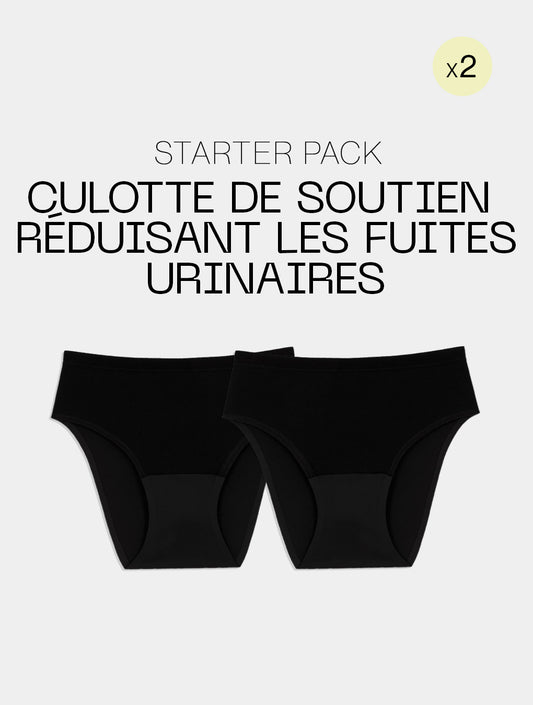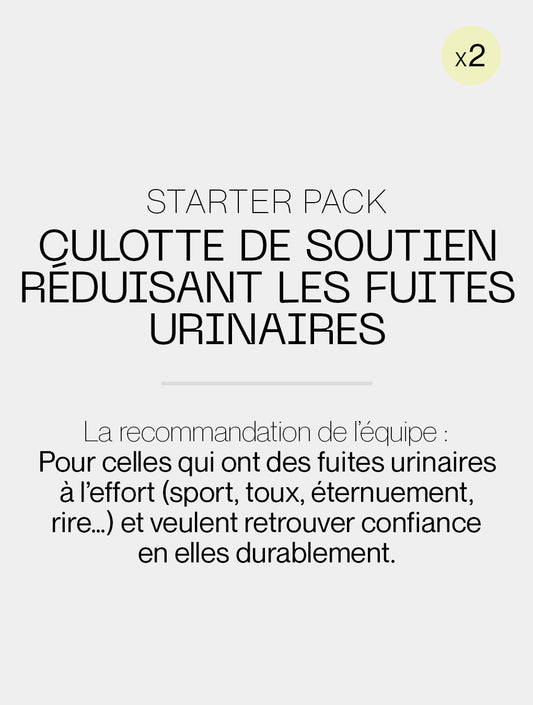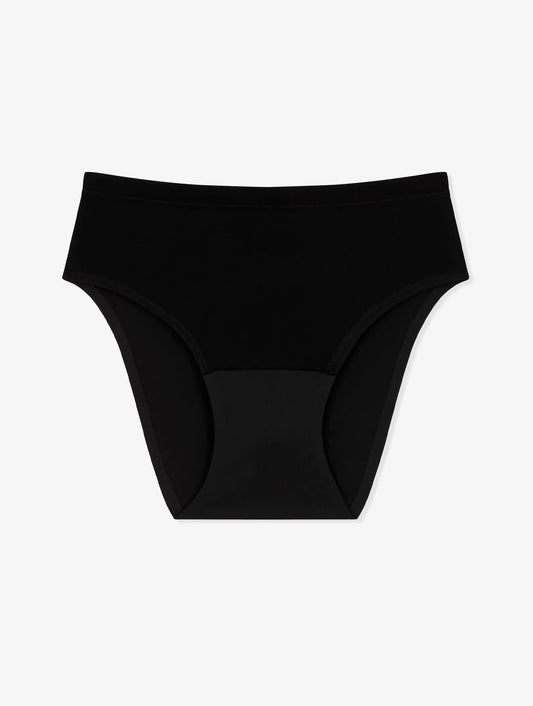Treatment of urinary incontinence: what to do about leaks?
Do you suffer from incontinence or does one of your loved ones suffer from the phenomenon of urinary leakage and are you wondering about possible treatments? We explain the solutions that exist to relieve women or make their lives easier in the event of urinary incontinence.
What to do against urinary leakage in addition to treatment for incontinence?
Your doctor's appointment won't arrive for 2 weeks (thanks medical deserts...)? Does it take a little time for your incontinence treatment to take effect?
Experience your urinary leakage more peacefully thanks to Smoon support panties which reduce urinary leakage and help you better cope with these complicated moments in addition to your treatment . Did you also know that Smoon was originally a French brand of menstrual panties ?
Understanding urinary incontinence
Urinary incontinence can be a source of embarrassment, but several solutions and treatments exist to deal with urinary leakage. Whether through urge or effort, urinary leakage can be treated with behavioral methods, medications, or even surgery to treat incontinence .
Perineo-sphincteric rehabilitation is often the first step. Hygiene and dietary advice can also help improve the situation.
Definition and symptoms of urinary incontinence
Urinary incontinence is defined as an involuntary loss of urine, day or night. It is both a hygiene and social problem, often referred to as “urinary leakage”. Symptoms vary depending on each individual, but can include leaking urine during exertion such as coughing, sneezing, laughing, or sudden movements.
A sudden and uncontrollable urge to urinate, also called "urgency", can also occur, not always leaving time to go to the toilet. There are several types of incontinence, including stress incontinence and urge incontinence, and therefore several forms of incontinence treatment.
How to treat urinary incontinence in women?
To treat urinary incontinence in women, several options are available.
- Perineal rehabilitation sessions , carried out by a physiotherapist or midwife, often constitute the first level of treatment. This targeted physiotherapy aims to strengthen the pelvic floor muscles.
- Drug treatment can also be considered, for example with desmopressin which limits the quantity of urine produced.
- In postmenopausal women, local estrogen treatment may be recommended in the absence of contraindications.
- Finally, in certain cases, surgical intervention may be proposed.
Perineo-sphincteric rehabilitation in the treatment of incontinence
Perineo-sphincter rehabilitation is a therapeutic method aimed at strengthening the muscles of the perineum to improve bladder control . It is often the first treatment offered in cases of urinary incontinence, in particular for stress incontinence.
Rehabilitation generally follows three key stages:
- Assessment: to assess the type and severity of incontinence.
- Rehabilitation itself: to strengthen the muscles of the perineum.
- Autonomy: to allow the patient to maintain the gains of rehabilitation.
This therapeutic approach, the first treatment against incontinence , is generally carried out by a physiotherapist or a midwife.
What is the treatment for urinary leakage most prescribed by doctors for a woman?
The most commonly prescribed treatment for urinary leakage in women depends on the type of incontinence.
- For urge incontinence, anticholinergic medications or muscarine receptor agonists are usually prescribed to reduce bladder spasms.
- For stress incontinence, perineal rehabilitation is often the first choice.
- In some cases, duloxetine , a medication that strengthens urinary sphincter contractions, may be used.
- For more severe cases, surgical treatments are considered for incontinence . It is essential to discuss with a healthcare professional to choose the treatment most suited to each woman's specific situation.
Everything you need to know about drug treatments for urinary incontinence

Anticholinergics: definition and use
Anticholinergics are a class of drugs frequently used in the treatment of urinary incontinence . They work by blocking nerve signals that cause muscle contractions in the bladder, thereby reducing overactive bladder symptoms such as incontinence and urinary urgency.
The use of anticholinergics as a treatment for incontinence may be considered in the case of urge incontinence , sometimes in combination with hormonal treatment depending on the patient. These include medications such as solifenacin or darifenacin, which increase the filling capacity of the bladder and reduce spasms of the muscles of the bladder wall.
It should be noted that several anticholinergics are reimbursed by health insurance, including oxybutynin and trospium chloride as part of treatment for urinary leakage. In the event of intolerance to an anticholinergic, it is recommended to change the anticholinergic.
Medications to urinate less: alternatives to Vesicare and Toviaz
Apart from Vesicare and Toviaz, there are other effective medications to reduce urinary frequency that can be used in incontinence treatment.
For example, Ditropan (oxybutynin) and Ceris are also indicated for the symptomatic treatment of urge urinary incontinence and/or urinary frequency in adults.
On the other hand, Mirabegron , a beta-adrenergic stimulant, relaxes the bladder wall, thereby increasing the bladder's filling capacity. However, it can also increase blood pressure.
Finally, in the event of resistance to drug treatment, palliative treatments such as protection, collection bags, bladder catheter, penile sheaths can be considered.
It is recommended to consult a healthcare professional to tailor treatment to your specific situation.
How does your doctor choose the best medication for leaks?
To choose the best medication for urinary leakage, several criteria must be taken into account by your doctor.
- First, the type of incontinence : certain medications are more suitable for stress incontinence, others for urge incontinence.
- Next, the patient's tolerance to possible side effects of medications must be considered.
- Finally, it is necessary to take into account the other pathologies from which the patient suffers, because certain medications can interact with other treatments.
It is your doctor and him alone who can help you choose the best treatment based on these criteria.
Surgical treatment of urinary incontinence
Suburethral sling placement: an effective solution?
Suburethral sling placement is emerging as a surgical treatment option for stress urinary incontinence, particularly in women. This surgical technique is considered minimally invasive and is characterized by its speed of execution.
It consists of installing a urethral support strip, generally made of polypropylene, which acts as a support hammock for the urethra , helping to prevent leaks during exercise. This procedure can be performed under local or regional anesthesia , often allowing you to return home the same day as the procedure.
According to some data, it has demonstrated its ability to cure stress urinary incontinence in more than 80% of patients who did not respond to conservative treatments.
However, like any surgical procedure, it is not without risk and can in certain cases lead to complications. It is therefore essential for each patient to discuss this option with their doctor to assess its suitability based on their specific situation.
Natural treatment for urinary incontinence
Natural methods to stop leaks in women
To naturally manage urinary leakage, several approaches can be considered. Kegel exercises are particularly recommended as a treatment for incontinence to strengthen the muscles of the perineum . These exercises involve contracting and relaxing these muscles, thereby improving their ability to hold urine.
Other methods of strengthening the pelvic floor may include practicing yoga . Specific postures can help gently strengthen these muscles.
In addition, the use of Geisha balls can be considered as part of a treatment against urinary leakage to strengthen the perineum . These devices are usually made of silicone and are inserted into the vagina to stimulate and strengthen the pelvic muscles.
Finally, herbal medicine offers several options for managing leaks, with plants like horsetail, known to strengthen the connective tissues of the bladder.
The role of diet and lifestyle
Diet is proven to play a crucial role in controlling urinary incontinence and is perhaps the first treatment for urinary leakage . Elements such as fiber, found in fruits, vegetables and whole grains promote intestinal transit and help maintain a healthy weight, thus reducing the risk of incontinence linked to obesity.
On the other hand, certain foods and drinks can exacerbate incontinence . Alcohol, tea, coffee and spicy, acidic or sweet foods stimulate the urge to urinate and therefore can increase leaking.
Lifestyle changes can also help manage urinary incontinence. In particular, it is recommended to exercise regularly, including pelvic floor strengthening exercises, and to limit fluid consumption before bedtime to reduce nighttime leaks.
It should also be noted that aging is a risk factor for urinary incontinence, but lifestyle adaptations can help reduce leakage.
Managing urinary incontinence on a daily basis

Medical products for continence
Medical products for continence are a valuable aid in managing urinary incontinence on a daily basis and limiting its impact on the quality of life of those affected.
These products can be of different types:
- Urine collection devices , such as absorbent pads or urinary shells, are designed to absorb and contain urinary leakage.
- Implantable medical devices , such as suburethral slings or pelvic reinforcement implants, are used in cases of severe urinary incontinence, especially when other treatments have failed.
- Certain medications, such as antispasmodics or alpha-adrenergic stimulants, can help control bladder tone and strengthen urinary sphincter contractions.
- At Smoon, we are convinced that support panties reducing urinary leakage are today your best companion in addition to treatment against incontinence.
It is essential to discuss with a healthcare professional to choose the most suitable product for each situation.
Tips for living with urinary incontinence
Living with urinary incontinence can be a challenge, but several strategies can help manage this condition on a daily basis:
-
Adopt a urination schedule: It can be helpful to note the times of the day when you need to urinate the most. This can help you anticipate and manage urinary leakage.
-
Use assistive devices: Tools like portable urinals or drinking reminder apps can be helpful.
-
Schedule bathroom breaks: Schedule regular bathroom breaks, especially before activities that could trigger a leak.
-
Maintain good intimate hygiene: It is essential to avoid urinary infections which could worsen incontinence.
-
Managing stress: Stress can make incontinence worse. Relaxation techniques like meditation or yoga can help reduce stress.
-
Adapt your diet: Certain foods can irritate the bladder and increase the volume of urine. It may be helpful to reduce the consumption of these foods.
These tips aim to improve the daily management of urinary incontinence, but they do not replace appropriate medical treatment for urinary leakage.
Urinary incontinence in the elderly
Special features and support
Urinary incontinence in the elderly presents certain particularities requiring specific care and appropriate treatment against urinary leakage . Indeed, factors such as aging, the presence of certain pathologies or taking specific medications can worsen symptoms.
The treatment may involve different health professionals, including the treating physician , the urologist , the obstetrician-gynecologist , or even the midwife . The treatment is chosen in consultation with the patient, taking into account the cause of the incontinence , the type of incontinence and the discomfort felt.
- Behavioral techniques can be implemented, such as establishing a voiding schedule.
- Medication treatment may be prescribed, taking into account possible side effects in the elderly.
- If other treatments fail, surgical intervention may be considered, such as the insertion of strips.
Finally, in cases of severe incontinence, continence aids can be offered to improve the daily life of the elderly person.
Associated medical problems
Urinary incontinence can be linked to various medical problems . Certain neurological disorders such as multiple sclerosis or diseases such as diabetes and high blood pressure can contribute to the onset of incontinence. Furthermore, recent surgery or specific drug treatments may also be involved.
Note also that urinary incontinence can be a warning sign of spinal cord damage . In all cases, a medical evaluation is necessary to identify the precise cause of the incontinence and adapt the treatment.
Solutions adapted to the elderly for the treatment of urinary leakage
The treatment of urinary incontinence in the elderly requires an approach adapted to their specific needs. Among the possible solutions, some are specific to this population.
-
Perineosphincteric or behavioral rehabilitation : this method consists of strengthening the muscles of the perineum to improve bladder control. It can be particularly effective for stress incontinence.
-
Drug treatment : certain medications can help control urinary incontinence. The choice of medication will depend on the cause and type of incontinence.
-
Increasing water consumption : it is recommended to drink between 1.5 and 2 liters of water per day to reduce the risk of urinary infection. It is best to drink at the start of the day to avoid nighttime leaks.
-
The use of continence aids : in cases of severe incontinence, devices such as protection or adult diapers can improve the elderly person's daily life.
It is recommended to consult a health professional who can establish a diagnosis and offer appropriate treatment for urinary leakage. The decision is made in consultation with the patient and taking into account the discomfort felt.




